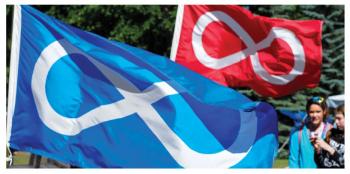Summary
Local Journalism Initiative Reporter
Windspeaker.com
This time when lawyer Jean Teillet says “give me the evidence” it’s not about courtroom proceedings. It’s about the history of the Métis flag.
Teillet is tired of reading on Facebook and other social media platforms or hearing in conferences that the white infinity insignia on the blue background flag was a gift to the Métis.
“When you say the flag was given to (the Métis) by the Northwest Company, it implies it was all the Northwest Company’s idea and that the Métis are just passive recipients or being manipulated by (the Company),” said Teillet, “and I just don’t think the evidence supports that view.”

Teillet is a partner in Pape Salter Teillet law firm with offices in Vancouver and Toronto. She is also a historian. She spent five years “digging deeply” into the history of the Métis Nation for her book The North-West is Our Mother, published in 2019 by HarperCollins Canada.
“There’s a common theme that runs through, I think, First Nations history, but certainly Métis history, the idea that (Métis) never came up with any ideas themselves. They never invented anything themselves, they never thought up, they never did anything themselves. Everything that happened … the responsibility is claimed by others,” she said.
It’s a belief that Teillet is passionate about refuting, and even more passionate about refuting when it’s something said by Métis themselves when it comes to the flag.
“It’s an urban myth because everybody believes it. You repeat it often enough and people believe it and the Métis are not immune in passing on poor and incorrect information. And that’s what’s going on,” she said.
Teillet’s latest battle came in a post on the Metis Nation of Alberta’s Facebook page on July 25 in which Alexander McDonnell (correct spelling is Macdonell) of the Northwest Company was credited with presenting Métis leader Cuthbert Grant with the flag in 1814. Teillet responded with, “MNA – stop saying this.”
Teillet says the Métis Nation of Ontario has also been “guilty of putting a lot of this stuff out.” Similar statements on the flag’s origin can also be found on other Metis websites, like the Fraser Valley Métis Nation, and in publications, like Flags of the Métis by Calvin Racette.
The problem, says Teillet, is that there is no evidence to support this common claim.
Update: In this document, developed by Jean Teillet and Adam McInnes after our story was published in July 2020, several claims commonly made about the Métis Nation’s Infinity Flag are presented and the historical sources are tracked. Métis Nation Infinity Flag-Sources Chart-Teillet McInnes-Aug2020.pdf - Google Drive
In her research, Teillet notes that the first recorded sighting of the flag was by James Sutherland from the Hudson Bay Company in 1815, in what he described as a horizontal eight on a red background. The next sighting is in June 1816 by fur trader Peter Fidler, who describes the horizontal eight on a blue background. Teillet stresses that the flag existed prior to this time, but these are the first recorded sightings.
Along with the lack of evidence supporting the origins of the flag, is the lack of documentation about why the flag consists of a white infinity symbol initially on a red background which soon became a blue background. Reasons for these have been offered, says Teillet, including the blue background to represent the Northwest Company and the red background to represent the Hudson Bay Company.
However, Teillet’s research, which included looking at Hudson Bay’s “amazing records” indicates something entirely different: it was about what was available at the time.
In 1815, calico, corduroy, plaid and stroud were popular fabrics. Stroud, a felt-like material used for coats, was the only practical material for the flag. Stroud came in the common colours of green, red and blue.
“When I think of the different colours, I think it’s just a function of practicality. I don’t think it was any design, or strategy or plan. I think … they needed another flag, they went to the store, probably this time they didn’t have red, they had blue. I think it was just as simple as that. I don’t believe that there’s anything to support any kind of great ideological (decisions),” she said.
“I just think all that stuff is just us people today applying meaning to things that I think were a lot simpler; reactions not reasons. You’ve got to place yourself where they were and what they were doing.”
Teillet admits that it can be difficult to obtain records on the topic. Métis history, which is primarily oral history, “can be distorted” although it is more accurate when referring to the “big picture” occurrences. European history, although written, can also be distorted depending on the intention of the writer.
“You’ve got to look at all of these things. Put them in context. Put them up against other records and try and figure out what you think the real story is,” said Teillet.
And as far as Teillet is concerned the “real story” about the Métis flag isn’t what’s commonly been said.
“Until somebody shows me evidence of it I will stand firmly on my line, which is don’t repeat that story. Just don’t repeat it and have some faith in your own people that they have the intelligence enough to come up with their own ideas and don’t attribute everything to everybody else,” she said.

Local Journalism Initiative Reporters are supported by a financial contribution made by the Government of Canada.

